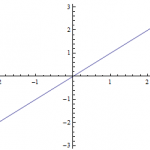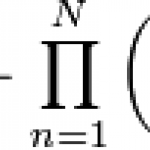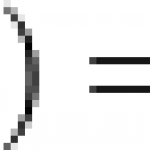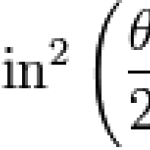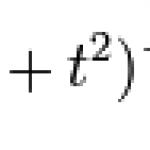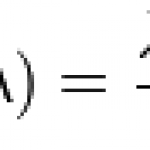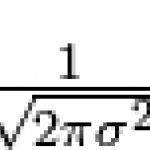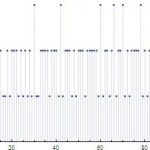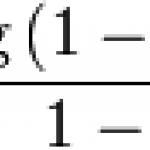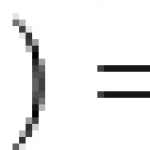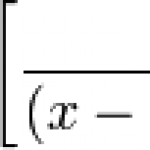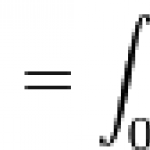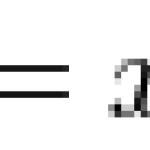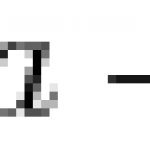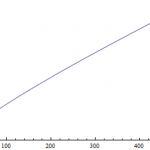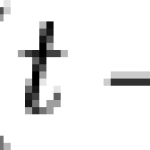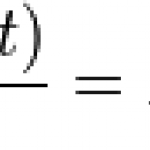Sunday Function
This is the graph of the line y = x:
If you put your finger down on any point on that line, and then put another finger on another point on that line, you find that the total change in the y-coordinate divided by the total change in the x-coordinate between those two positions is 1. Move two units to the right, and the line rises by two units, etc. This is the same no matter which two points you pick. Every line has this sort of property, which is called slope. Steep lines that rise greatly for each unit of x displacement have a large slope, flat horizontal lines have zero slope, and…
Sine, cosine, and tangent are of course the workhorse functions of trigonometry. You learn 'em in high school, and if you go on in math and science you never stop using them. Now on many occasions you might have the sine or cosine or tangent of some angle, and you want a way to invert those functions to recover the angle from those values. Let's take a look at the inverse tangent function:
Now we'll do one of those things were we skip any motivation and just do some stuff for reasons we'll get to at the end. Let's find the derivative of the arctangent function. To start, take the…
This Sunday I was at an event that involved a number of drawings for door prizes. There were perhaps 30 couples there - it was, not to beat around the bush, a wedding registry shindig at Bed, Bath, & Beyond. (Did I mention I'm recently engaged? I am. It's the main reason for the endemic light posting, as I'm afraid the wedding bumps the blog down the priority list a bit. ;) )
There was something in the vicinity of 8 or so drawings from separate bowls, and each couple's number was placed in each bowl. The rules were such that a couple could only win once. One number was pulled twice…
Here's a simple function that's not so often found in mathematical physics, but it's still a nice showpiece for exhibiting some interesting behavior:
I've only plotted it for positive real x, because for x less than zero it starts spitting out complex numbers in a very unfriendly way. We're only considering it along the domain in which it's purely a real function. Just from the graph it's clear that this is a very fast-growing function. This isn't exactly a shock. 3^3 = 3x3x3 = 27, while 5^5 = 5x5x5x5x5 = 3125. Larger x produces much larger f(x) at an astonishing rate.
But just what…
Step right up, Ladies and Gentlemen! Get your ticket to see the True Oddities of the Natural World! Do not be taken in by the Shameful Forgeries at Inferior Circuses, here you will see Genuine Curiosities from the Mists of Time! Beside these Archaic Functions, the Two-Headed Horse or Whatever is a Mere Bagatelle!
So, why do we bother having a sine and a cosine? They're the same thing, one just happens to be shifted. Whatever angle you plug into cosine, you'll get the same result if you plug that angle plus 90 degrees into the sine. Why not just scrap one of them entirely and just teach…
And now, two quick notes before we get to business:
1. God help me, but I've joined the Twitter bandwagon. Here I am, @BuiltOnFacts. Though it goes under this blog's name, it is more of a "personal" account. So you'll be reading some incomprehensible personal minutiae, random observations, wild assertions, and somewhat more politics that I typically introduce here. But you may enjoy it nonetheless, and if you ever have physics questions that can be answered in 140 characters feel free to fire away.
2. Speaking of politics, this paragraph is political and I dislike it when people…
...you've got to ask yourself one question: 'Do I feel lucky?' Well, do ya, punk?
- Dirty Harry
The laws of probability, like most of the mathematical rules that govern the world, are a relatively recent discovery. Ancient people like the Romans loved to gamble as much as we do, and they had at least some idea of how certain kinds of odds worked, but they'd probably have been flummoxed by many of the mathematical tools we use today to study chance. But then again, how many people at your average casino understand how to calculate the probabilities that govern the flow of their money? Well…
There's an interesting contrast between the laws of nature and the laws which constitute our legal system. The laws of nature are compact and precise; written in standard notation without accompanying explanation, the fundamental laws fit on a few pages. The laws of the legal system span thousands of volumes and are frequently ambiguous and ever-changing. On the other hand, we know what the laws of the land actually are. The laws of nature are not completely explored; there's large regions of the parameter space where we just don't know the laws at all. Still, in that sense physicists…
We've spent more than a few Sunday Function features discussing the properties of the prime numbers. They're just so important and interesting in number theory that they're an irresistible target. Let's set some scenery before getting to the actual function this week.
There are an infinite number of prime numbers. Whatever gargantuan prime number you find, there's always an infinite number of larger ones waiting to be found. However, their relative commonness does decrease as the numbers get larger and larger. For instance, while the ten ousand numbers 1-10,000 contain 1,229 primes, the…
Before her career took an unfortunate wrong turn, a young and talented Lindsay Lohan gave us a charming and popular comedy called Mean Girls. Time has been good to the careers of some of the others involved, Tiny Fey and Rachel McAdams perhaps most notably. But the film did something that very other movies have ever done - given us a climax explicitly involving a function of a real variable:
Lindsay's character is asked to find the limit of this function as x approaches zero. We notice that the function is not defined at zero - in the denominator, cos(0) = 1. This means we have 1 - 1 = 0…
Here's a very simple function:
You give it a positive real number, it gives you the square root. It maps 81 to 9, 100 to 10, 2 to 1.414..., and so on and so forth. It's pretty much the only one-argument function that's built into most pocket calculators, which says something about its utility and ubiquity. But let's say we did want to come up with an easy way to get approximate square roots. Maybe our calculator is broken, or (much more likely) maybe we're looking for an analytic approximation that's easier to deal with than the square root in and of itself. To generate our…
Just a quick one today, as I get caught back up from Thanksgiving. We all know and love the very basic quadratic function. Any second-order polynomial will give you a nice little parabola, which of course is ubiquitous in physics. We all know what that looks like. But what if we're willing to square complex numbers instead of just real numbers? Traditionally we denote complex numbers with z instead of x, so our Sunday Function is:
Ok, so what happens when we square a complex number? Well, we can write any complex number as (a + bi), where "a" and "b" are real numbers. "a" is the real…
If you look at an incandescent light in a spectroscope, you'll see a broad and continuous range of light emitted over a large portion of the visible spectrum. This combination of colors looks white to us. At the other extreme, laser light generally consists of just a tiny slice of the frequency spectrum, and so it appears highly monochromatic. The laser light is not literally mathematically all of the exact same frequency, instead it's distributed closely about the laser frequency according to some probability distribution that can vary depending on the specifics of the laser.
Very…
We're doing two functions today. If I'm not mistaken we've done each of them separately, but there's a famous and interesting relationship between the two that's always interesting to look at. Like very many interesting mathematical facts, it has to do with the prime numbers.
As such the first function is the log integral Li(x), usually defined in the following way:
We'll plot it in a minute, but if you're interested in a rough idea of it's behavior it so happens that Li(x) ~ ln(x)/x. That is, those two functions have a smaller and smaller percentage difference as x becomes larger.
Now…
Again I have to apologize for the sparseness of posting lately, but I've got two research projects going full blast and time has not been something I have a lot of. I'll still be writing at least a few times a week, and you can't beat the price. ;) In any case once things cool down just a little I should be back to a more regular schedule.
Today's function isn't interesting because of the function itself, the interest comes from what we'll do with it. Let's say we have a function like this:
If we want to see where the function is equal to zero, it's clear that 0 = x^2 - 2 is solved by x…
Edit: The previous version of this post required some fixing, as I boneheadedly mixed up the O and Ω notations. The rest of it should still be good.
When you invest in stocks, bonds, mutual funds, or just about any other major investment vehicle, you'll hear a standard but important disclaimer. "Past performance is not a reliable indicator of future returns." And it's wholly true. The hottest mutual fund of the last five years will very frequently revert to the mean over the next five. Or, start a Harley Davidson and an F-22 on the same runway and for the first few seconds the motorcycle…
All right, here's a fun one. It usually comes as part of a story. The story as told is mostly true, though a few details have been a little fudged by the winds of history. It goes like this: when the young Carl Gauss was a small child in school, his teacher wished to kill some time by making the students practice their addition by adding the integers from 1 to 100. Gauss worked for about 10 seconds and turned in the correct answer. His method was exceptionally clever. By doing the problem twice he made the calculation much easier.
First he wrote down the problem, calling the unknown…
Sometimes in math we'll understand one aspect of a problem very well, while at the same time we understand another aspect of a problem very poorly. For instance, take the prime numbers. According to the prime number theorem, the number of prime numbers below x is approximately given by:
Where pi(x) is the prime counting function and ln(x) is the natural logarithm. As you keep counting your way up the number line, you'll encounter more and more primes. They thin out and become more and more rare, but nonetheless there's an infinite number of them as you keep going. The number that you…
The vast majority of the functions we've talked about over all these Sundays have been ones that are expressible as a relationship between two numbers x and y. Sometimes the relationship is simple, sometimes it's fairly complicated. Mostly though, we just work according to the function as though it were a little machine. Take a number x, do to it what the function tells you to do, and the result is the number y. This is a function where the relationships between x and y are given in a very clear and explicit form.
But a function doesn't have to be given in that way. The only requirement…
Anybody heard of the idea of The Singularity? Roughly, it goes like this: technological progress builds on itself, and this self-reinforcing feedback loop is eventually going to come to a head where humanity makes a quantum leap into an unknowable and godlike transhuman technological future - possibly as early as the middle of this century. The name of the idea comes from mathematics, where approximately speaking a singularity is a place where a function rockets off to infinity. Alternately, some adherents of this type of thinking believe that progress is exponential; formally this doesn't…
